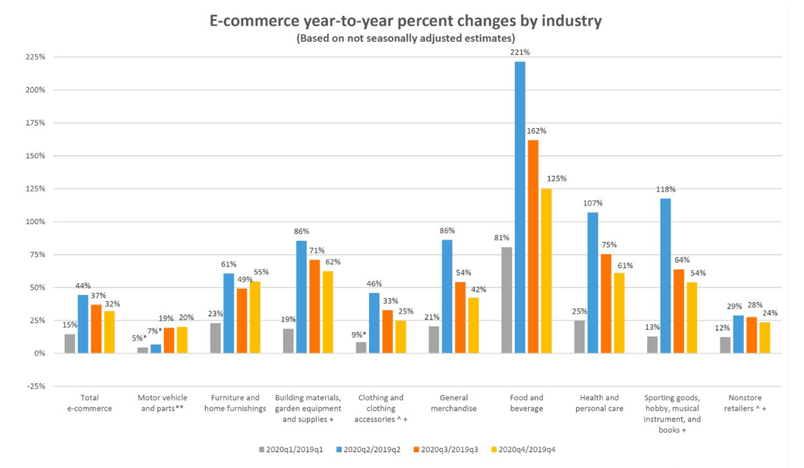The Complete Guide To D2C (Direct-to-Consumer) eCommerce
D2C, or Direct-To-Consumer, is a model where a company that manufactures products at its own facility also packages and sells them directly to the customer through its own channels, channels like an e-commerce store, social media handles, and physical stores.
Sounds a lot like B2C, where businesses sell directly to customers as well, so what differentiates D2C from B2C? The difference lies in who manufactures the products. While both models involve brands selling to customers directly, D2C brands are those that have also manufactured the products themselves.
A B2C business is any brand that sells to customers, period. They don’t necessarily have to have manufactured the product themselves, for example, retailers who also sell products directly to customers but source them from third-party vendors and manufacturers.
Essentially, all D2C brands are B2C because they sell directly to customers, but not all B2C brands are D2C because they don’t all manufacture their own products.
Understanding this difference is vital for brands in deciding which model to adopt.
Why Do Brands Adopt D2C?
1. It allows brands to deliver a unique experience, which supports growth
In the conventional retail model, the products begin with the manufacturer, move to the wholesaler, distributor, retailer, and then to the customer. In most cases, the manufacturer gets little to no recognition and completely relies on the retailer for sales and growth.
In the D2C model, all the middlemen – the wholesaler, distributor, and retailer are eliminated, allowing the manufacturer to sell directly to the customer.

The disconnect between the manufacturer and consumers is bridged, giving the manufacturer control over their brand, the customer experience, marketing campaigns, sales processes, and so on. It allows the manufacturer to actually create a brand and navigate it in the direction they want, and when done right, it helps the manufacturer grow faster.
2. To collect valuable data and feedback
Because D2C brands have a direct connection with their end-users, they now have access to vital data that can help them create a customer data platform to improve products and services. Without middlemen, D2C brands eliminate the chance of feedback being Chinese whispers and get valuable information straight from the users of their products.

Good data platform can help with:
- Consumer preferences – what products customers like and what they don’t like, what products will sell better as bundles, what pricing models are favored, and so on.
- Upsells/Cross-Sells – D2C brands can upsell and cross-sell products in their inventory directly through their channels and base these promotions on customer data. Here are more ways to increase your average order value and customer lifetime value.
- Feedback and product improvement – Through feedback, brands can improve their products and services to better serve customers.
3. It fosters loyalty and retention
Nurturing brand loyalty is extremely valuable. It costs five times more to acquire a new customer than it does to retain an old one and the success rate of selling to an existing loyal customer is 60-70%, while the success rate of selling products to a newly acquired customer is just 5-20%. (Source)
Loyalty, however, is driven by experiences. In the conventional retail model, product manufacturers are just the suppliers while the retailer delivers the customer experience. Fostering loyalty lies in the hands of the retailer, and in most cases, the loyalty is directed to the retailer and not the manufacturer. This does not help the manufacturer in any way. Once the customer is loyal to the retailer, they will continue to shop with them even if they change manufacturers. This can clearly be risky for manufacturers.
In the D2C model, manufacturers reclaim control of the customer experience. They can create strategies to foster loyalty and increase customer retention and ensure they have a loyal customer base for their products.
4. Better profitability Avenues
Product prices inflate as they move through the tracks from manufacturer to retailer. Each member (wholesaler, distributor, and retailer) adds a markup to the price and sells it to the next member. Customers buy it at the final price marked by the retailer.
In the D2C model, since the middlemen are cut out, the asking price for a product drops drastically. This creates an opportunity for manufacturers to increase the selling price and, thus, margins while staying below the retailers asking price. This enables the brand to earn more while customers pay lesser than they would, a win-win.
Is Direct to Consumer (D2C) a Good Fit for Your Business?
We made D2C seem like it’s all rainbows and butterflies, but the retailer B2C model exists and still thrives for a reason. Not all manufacturers can incorporate the D2C model and survive. There are some aspects you should first look into before considering which model will be best for you.
1. Is there an opportunity for D2C?
The first question you have to answer is if there is an opportunity – an opportunity for sales and an opportunity for growth. Some areas to look into when considering this question:
Existing customer base – What is the current market like? Does your product (or products) have an existing customer base, either created through a retailer or generated through premarketing? When you go D2C, will there be demand from day one, or will you have to generate awareness first?
Understanding the current demand will give you an idea of how quickly your D2C brand will be profitable, and how much money you need to survive until it begins generating profits.
Marketing scope – Marketing will generate awareness and consequently, sales. The scope for marketing will be determined by – first, the products and second, the budget. Certain brands and products do not suit certain marketing channels. You hardly see retailers promoting clothes on a professional platform like LinkedIn. Your products and value propositioning will determine which platforms are open to you.
The second factor will be the budget. Depending on how much money you can divert into marketing, some platforms and strategies will be unavailable to you. After analyzing 1 and 2 together, do you see marketing potential?
Other modes of promoting – Is there scope for promoting the brand and products in other ways? For example, adding inserts in shipments to give buyers discount codes or upsell/cross-sell information
While the earlier marketing analysis was geared more toward acquiring new customers, these promotions are geared toward customer retention and repeat orders. Together, they form the pillars for sales and growth.
2. Are the costs viable?
Once you evaluate the opportunity on paper, you need to ask if you have the funds available to incorporate a D2C model. There are a lot of costs like distribution and marketing that are eliminated when you sell through a retailer. In the D2C model, you are responsible not just for manufacturing, but storage, packaging, and distribution as well.
a. 3PL Warehouse vs. In-House Logistics – Will you manage order fulfillment in-house or through a 3rd party logistics provider (3PL)?
Inhouse fulfillment gives you complete control over logistics. You also have control over the customer experience.
When you go the 3PL route, you save on upfront costs (for a warehouse, for example) and also on day-to-day operations. You also get access to their expertise in logistics and resources from day one.

You should decide based on your budget and estimated order volumes. If order volumes are projected to be high right from the start, or if you predict erratic order volumes, you are better off partnering with a 3PL logistics provider.
b. Warehouse vs. Distribution Center – A warehouse is used to store products; a distribution center stores products and offers additional value-added services like packaging, loading, tagging, and so on. A distribution center, basically, performs all the processes needed to fulfill an order.
Your choice between the two will depend on whether you are choosing to fulfill distribution in-house or through 3PLs.
c. Earning potential – You already know the cost of goods sold, or how much you spend to manufacture each unit of the product. Once you plan out marketing and logistics, you will also know the costs for operations. The question now is if the D2C model is sustainable for your brand.
This will come down to the potential earnings, which will depend on:
- Average order value
- Average items per order
- Average shipping cost
Potential earnings will be the order value x items per order – shipping cost.
d. Alternatives to improve profitability
Lastly, you should account for future possibilities for profitability. Different processes or modules that you can incorporate to increase profits for the same product volumes. For example:
Subscriptions – Can you create a subscription model that customers will accept? Subscriptions are great to nurture loyalty and retention and also create a continuous earning stream.
Bundles – Can you bundle products and create different pricing plans to include all ranges of customers – those who want to buy single products and pay a lesser amount per transaction and also those who are willing to pay higher amounts per transaction for high-value products or bundled products
3. The hurdles to implementing D2C (Direct to Consumer eCommerce)
a. Retail partner objections – When you move to the D2C model, you become a direct competitor for retailers selling similar products. Are you going to face backlash from retailers currently selling your products or similar products? Will you be able to weather the competition and position your brand as unique from theirs?
b. Different product offerings/bundles – As you become a direct competitor to retailers, will their product offerings, pricing plans, or product bundles take business away from you? It’s a prudent approach to research your competition and pit their services against your own. For you to survive as a D2C brand, you will have to deliver better pricing deals than the competition.
c. Can you differentiate your brand from the competition – You will need a USP to differentiate your brand from the competition. While not every product or service can be unique, you can introduce a distinction in other areas like operations, pricing, or support.
Conclusion about Direct to Consumer eCommerce (D2C)
D2C sales in the US rose from $76 billion in the year 2019 to $111.5 billion in the year 2020. Sales were forecasted to increase to $129 billion in the year 2021. The D2C market is growing quickly, as more manufacturers begin to see the immense benefits of building a brand.
If you are considering starting a D2C business or moving from a retail-oriented business to D2C, this article will hopefully serve as a guide to you.


![eCommerce Business Trends 2020 Predictions [DATA & GRAPHS]](https://atmosol.com/wp-content/uploads/2023/02/Featured-image.png)















